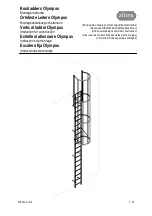
4
BoSS Teleguard
PLUS
Instruction Manual
4
Transportation And Storage
•
Store ladders in such a way that they cannot be damaged (e.g. bent or
twisted).
•
Protect ladders from the influence of weather and keep them from
unauthorised use (e.g. by children) while they are in storage.
•
While transporting ladders to or from the place of storage, they should be
properly secured to keep them from sliding and prevent impact and accidents.
•
Do not throw the ladders during loading and unloading.
•
When transporting ladders, properly secure them on a vehicle’s roof racks or in
its interior.
•
Use good manual handling practices & techniques when erecting, dismantling,
moving, transporting and handling a ladder.
•
Only move ladder in closed position and with the product laying in horizontal
position.
•
Use the platform top guardrail as a hand hold and raise until the castors
contact the floor. Move ladder to desire position, lower and re-erect.
5
Safety Instructions
5.1
Before Use
•
Read all instructions on and
accompanying the ladder.
•
WARNING! Fall from the ladder
•
Inspect the ladder after delivery.
Before every use visually check the
ladder is not damaged and is safe
to use.
•
Do not use a damaged ladder.
•
Do not use the ladder if you are
not fit enough. Certain medical
conditions or medication, alcohol or
drug abuse could make ladder use
unsafe.
•
Ensure the ladder is suitable for the task.
•
Visually check the ladder is not
damaged and is safe to use at the
start of each day when the ladder is
to be used.
•
Inspect ladder feet.
•
Do not use the ladder if contaminated, e.g. with wet
paint, mud, oil, water or snow.
•
Prevent damage of the ladder when transporting
e.g. by fastening and ensure they are suitably
placed to prevent damage.
•
For professional users regular periodic inspection
is required.
•
For professional use, a risk assessment shall be
carried out respecting the legislation in the country
of use.
•
Do not modify the ladder design.






















